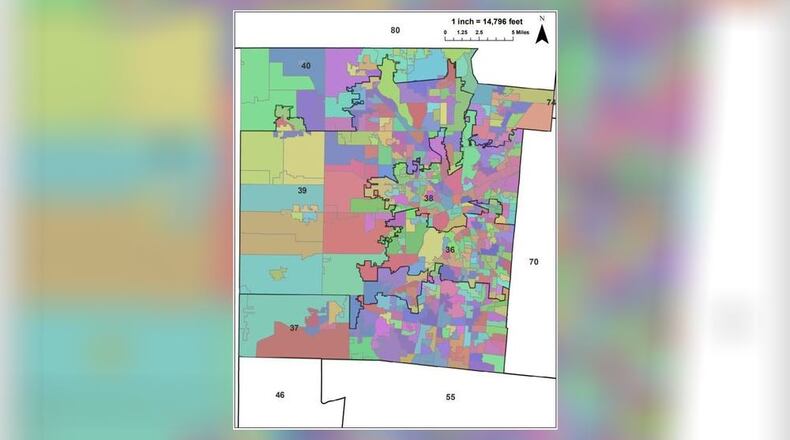The board certified the petitions at the directive of Secretary of State Frank LaRose, despite the fact that the Ohio House, Ohio Senate, and U.S. Congressional district maps are part of ongoing litigation at the state Supreme Court.
“All of the petitions we’re approving today are reflective of the current maps in the state of Ohio, with regard to the U.S. Congressional seat, as well as the state seats,” Montgomery County BOE Director Jeff Rezabek said late Tuesday, noting that the maps are subject to change depending on the Supreme Court decisions.
Another change in maps now could jeopardize the ability to hold a May primary election as scheduled, Greene County BOE Deputy Director Llyn McCoy said. Military absentee voting begins March 18, and regular early voting is scheduled to start April 5.
“If we have to start over, I don’t think we could come back any earlier than June,” McCoy said.
State legislature races
If the state legislative maps stay the same, Greene and Montgomery counties combined will have only one contested May primary — a Republican race in the 70th district between incumbent state Rep. Brian Lampton and challenger Katherine Shutte. The winner of that primary would face Democrat Eric Price in November, according to the Greene County Board of Elections.
Incumbent state Sen. Steve Huffman, R-Tipp City, has no opposition at all in his state senate race — neither for the May primary, nor the November election. In Montgomery County, incumbent Republican state Reps. Phil Plummer and Tom Young are in the same position, with no challengers at all, as is Democratic state Rep. Willis Blackshear.
Three other local state House districts have just one Democrat and one Republican candidate, meaning those races are set for November. In Greene County’s 71st House district, Democrat James H. Duffee will challenge incumbent Republican state Rep. Bill Dean.
In Montgomery County, Democrat Addison Caruso will challenge incumbent Republican state Rep. Andrea White in the 36th House district, and Democrat Amy Cox will challenge incumbent Republican state Rep. Rodney Creech in the 40th House District.
Miami County’s Board of Elections was meeting late Wednesday to certify candidates, and Warren County’s Board of Elections was still in the process of scheduling its meeting, possibly for Monday, according to BOE Director Brian Sleeth.
How the process works
In Ohio, district lines are redrawn every 10 years after the completion of the U.S. Census. Districts must have nearly equal populations and must not discriminate on the basis of race or ethnicity.
In November, legislators passed a new U.S. House map, but voting-rights and progressive groups filed suit. The Ohio Supreme Court threw out that map on Jan. 14 as unfairly favoring Republicans, and told the General Assembly to try again.
The General Assembly took no action, however, sending the job back to the Ohio Redistricting Commission, which has also worked on several versions of state House and Senate district maps — so far overturned twice by the state Supreme Court as also gerrymandered to favor Republicans.
Last week, the Ohio Redistricting Commission approved a new Republican-authored map of U.S. House districts by a 5-2 party-line vote, drawing no Democratic support. Both opponents of the Republican-drawn map and the map’s supporters on the Ohio Redistricting Commission filed arguments in related lawsuits this week. As of Wednesday, the issue is still under state Supreme Court litigation.
The Ohio Secretary of State’s office has sent numerous directives to boards of elections throughout the litigation process to instruct them on how to proceed with preparation for the May 3 primary, which included instructions to certify candidate petitions based on district maps as they currently stand.
Local elections staff speak
Montgomery County Board of Elections Deputy Director Sarah Greathouse said once the Supreme Court makes a ruling, the board will be in a race against time to ensure everything is in place in time for the May election, pointing out that ballot proofs should have already been sent for print last Friday.
“There are a number of impacts of the Supreme Court ruling these maps unconstitutional,” Greathouse said. “Some of them involve the work (within BOE meetings), but most of it is administrative and most of it is going to impact when and how we administer the election because changes have to be made in multiple places.”
McCoy, from Greene County, said the biggest challenge is proofing the ballots, because there’s hardly any time to make sure there are no mistakes.
When changes are made to district maps, Greathouse said, BOE staff must then manually make the corresponding changes within the voter registration system, which assigns voters to districts, and within the election management system, which makes sure every voter gets the correct ballot.
“Because of security reasons, among other things, these systems don’t speak to each other easily, and that’s where the human element comes in,” she said.
Greene County is also currently looking for poll workers. The legislature is providing boards of election with funds to hire seasonal workers to be “fresh eyes” for the verification process, but it may not be enough.
“We need time, and money can’t buy that,” McCoy said.
“I’m afraid that people are going to be discouraged and confused and decide, ‘Well, I’m not even going to vote,’ which is the worst thing that could possibly happen,” McCoy said.
Staff Writer Jim Gaines contributed to this report.


